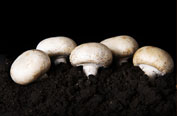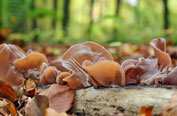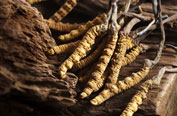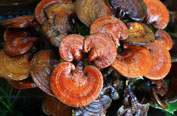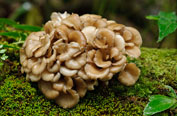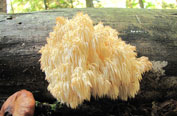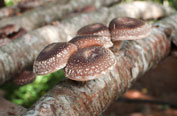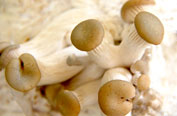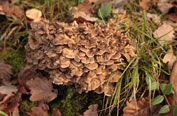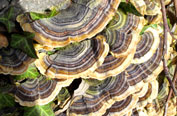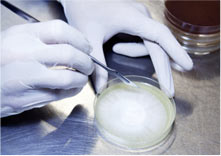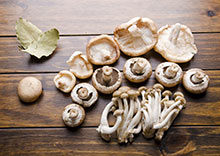
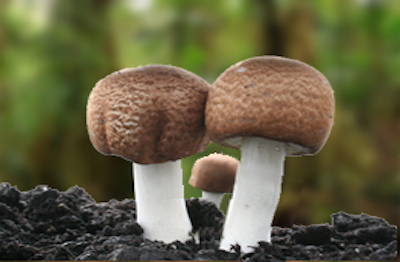
Allgemeines
-
Agaricus blazei Murrill
Synonyme: Mandelpilz, ABM, Brasilianischer Mandel-Egerling, Sonnenpilz, Lebenspilz, Cogumelo de Deus
Inhaltsstoffe: u.a. Polysaccharide, Peptid-Glucane, Ergosterin, Konjugierte Linolsäuren (CLA), Pantothensäure, FolsäureTraditionelle Anwendungsgebiete:
- Begleitend zur Krebstherapie (1-14)
- Diabetes (4, 23)
- Allergien (15, 24, 25)
- Leberstärkend (16-19)
- Stimulierung der Immunabwehr (20-22)
Im Kampf gegen bestehende Allergien, und auch zum Schutz vor Allergien (beim sogenannten igE-vermittelten Soforttyp) wird der Agaricus blazei Murrill als vielversprechendes Mittel angesehen (sh. Agaricus blazei Murrill (15)).
Im Bereich der zellulären Immunantwort wirkt sich eine Behandlung mit Agaricus blazei Murrill auf die Aktivität von Monozyten und Granulozyten aus; das Phagozytosepotential wird erhöht bzw. der Eintritt in entzündete Zonen gefördert. Diese Wirkung wird auf den hohen Beta-Glucan-Gehalt des Agaricus blazei Murrill zurückgeführt (sh. Agaricus blazei Murrill (21)).
Der Agaricus blazei Murrill aktiviert u.a. den für anti-infektiöse und anti-tumorale Tätigkeit verantwortlichen Teil des Immunsystems (sh. Agaricus blazei Murrill (20)).
Agaricus blazei Murrill kann auch das Risiko von Metastasen bei bestimmten Krebsarten senken. So zeigte die Behandlung von Krebszellen mit Polysaccharidextrakt vom Mandelpilz in-vitro deutliche Erfolge bei Lungen- und Eierstockkrebs und bei in-vivo-Untersuchungen bei Eierstockkrebs beim Menschen. Darüber hinaus wurden deutliche Synergieeffekte bei Chemo- und Strahlentherapie beobachtet (sh. Agaricus blazei Murrill (1)).
Über den Pilz:
Verbreitung und Habitat in der Natur:
Bodenbewohner (kompostreiche Böden). Ursprünglich aus Brasilien.Verwendung:
Speisepilz, VitalpilzDer Mandelpilz weist eine besonders ausgewogene Konzentration an Vitaminen, wertvollen Mineralstoffen, Eiweißen und Aminosäuren sowie einen hohen Anteil an Polysacchariden auf. Nicht nur diese Bestandteile, sondern auch sein charakteristisches Mandelaroma zeichnen den Agaricus blazei Murrill als einen hochwertigen Speise- und Vitalpilz aus.
Studien
-
Wissenschaftliche Studien über Agaricus blazei Murrill
1) Suppressing effects of daily oral supplementation of beta-glucan extracted from Agaricus blazei Murill on spontaneous and peritoneal disseminated metastasis in mouse model. Kobayashi H, Yoshida R, Kanada Y, Fukuda Y, Yagyu T, Inagaki K, Kondo T, Kurita N, Suzuki M, Kanayama N, Terao T. J Cancer Res Clin Oncol. 2005;131(8):527-38.
2) Effects of Agaricus brasiliensis mushroom in Walker-256 tumor-bearing rats. Jumes F.M, Lugarini D, Pereira A.L, de Oliveira A, Christoff Ade O, Linde G.A, do Valle J.S, Colauto N.B, Acco A. Can J Physiol Pharmacol. 2010;88(1):21-7.
3) Inhibitory mechanisms of Agaricus blazei Murill on the growth of prostate cancer in vitro and in vivo. Yu C.H, Kan S.F, Shu C.H, Lu T.J, Sun-Hwang L, Wang P.S. J Nutr Biochem. 2009;20(10):753-64.
4) Immunomodulating activity of Agaricus brasiliensis KA21 in mice and in human volunteers. Liu Y, Fukuwatari Y, Okumura K, Takeda K, Ishibashi KI, Furukawa M, Ohno N, Mori K, Gao M, Motoi M. Evid Based Complement Alternat Med. 2008;5(2):205-219.
5) Natural killer cell activity and quality of life were improved by consumption of a mushroom extract, Agaricus blazei Murill Kyowa, in gynecological cancer patients undergoing chemotherapy. Ahn W.S, et al. Int J Gynecol Cancer 2004;14(4):589-594.
6) Clinical observation on treatment of acute non lymphocytic leukemia with Agaricus blazei. X. Tian, Z. Lun and H. Ito. J. Lanzhou Med. Coll. 20 (1994), pp. 169–171
7) Observation on treatment effect of Agaricus blazei against alimentary tract tumor. Wang J., Mou X.M. and Cheng R.Z. Gansu Med J. 1994;13:5–7
8) White button mushroom phytochemicals inhibit aromatase activity and breast cancer cell proliferation. Grube B.J, Eng E.T, Kao Y.C, Kwon A, Chen S. J Nutr. 2001;131(12):3288-93.
9) Anti-aromatase activity of phytochemicals in white button mushrooms (Agaricus bisporus). Chen S, Oh S.R, Phung S, Hur G, Ye J.J, Kwok S.L, Shrode G.E, Belury M, Adams L.S, Williams D. Cancer Res. 2006;66(24):12026-34.
10) Medicinal properties and clinical effects of culinary-medicinal mushroom Agaricus blazei Murrill (Agaricomycetideae) (Review). Mizuno T. Int J Med Mushr 2002;4:299–312.
11) Agaricus blazei (Himematsutake) does not alter the development of rat diethylnitrosamine-initiated hepatic preneoplastic foci. Barbisan L.F, Spinardi-Barbisan A.L, Moreira E.L, Salvadori D.M, Ribeiro L.R, da Eira A.F, de Camargo J.L. Cancer Sci. 2003;94(2):188-92.
12) Screening for in vitro and in vivo antitumor activities of the mushroom Agaricus blazei. Ziliotto L, Pinheiro F, Barbisan L.F, Rodrigues M.A. Nutr Cancer. 2009;61(2):245-50
13) Variation of the antimutagenicity effects of water extracts of Agaricus blazei Murrill in vitro. Guterrez Z.R, Mantovani M.S, Eira A.F, Ribeiro L.R, Jordão B.Q. Toxicol In Vitro. 2004;18(3):301-9
14) Effects of the medicinal mushroom Agaricus blazei Murill on immunity, infection and cancer. Hetland G, Johnson E, Lyberg T, Bernardshaw S, Tryggestad A.M, Grinde B. Scand J Immunol. 2008;68(4):363-70
15) An extract of the medicinal mushroom Agaricus blazei Murill can protect against allergy. Ellertsen L.K, Hetland G. Clin Mol Allergy. 2009:5;7-6.
16) The mushroom Agaricus blazei Murill extract normalizes liver function in patients with chronic hepatitis B. Hsu C.H, Hwang K.C, Chiang Y.H, Chou P. J Altern Complement Med. 2008;14(3):299-301
17) Clinical utility of ABCL (Agaricus Mushroom Extract) treatment for C-type hepatitis. Jpn Pharmacol Ther. 2002;30:103-7
18) Observation on the treatment effect of Agaricus blazei to the liver function of chronic hepatitis patients. Wang L. and Ma H. J Lanzhou Med Coll. 2004;20:24–26
19) An alternative medicine, Agaricus blazei, may have induced severe hepatic dysfunction in cancer patients. Mukai H, Watanabe T, Ando M, Katsumata N. Jpn J Clin Oncol. 2006 Dec;36(12):808-10.
20) Hetland G, Johnson E, Lyberg T, Bernardshaw S, Tryggestad AM, Grinde B (2008). "Effects of the medicinal mushroom Agaricus blazei Murill on immunity, infection and cancer". Scand J Immunol 68 (4): 363–70. doi:10.1111/j.1365-3083.2008.02156.x. PMID 18782264.
21) Bernardshaw S, Lyberg T, Hetland G, Johnson E: Effect of an extract of the mushroom Agaricus blazei Murill on expression of adhesion molecules and production of reactive oxygen species in monocytes and granulocytes in human whole blood ex vivo. APMIS. 2007 Jun;115(6):719-25.
22) Bernardshaw S, Hetland G, Ellertsen LK, Tryggestad AM, Johnson E: An extract of the medicinal mushroom Agaricus blazei Murill differentially stimulates production of pro-inflammatory cytokines in human monocytes and human vein endothelial cells in vitro.
Inflammation. 2005 Dec;29(4-6):147-53
23) Hsu CH, Liao YL, Lin SC, Hwang KC, Chou P: The mushroom Agaricus Blazei Murill in combination with metformin and gliclazide improves insulin resistance in type 2 diabetes: a randomized, double-blinded, and placebo-controlled clinical trial. J Altern Complement Med. 2007 Jan-Feb;13(1):97-102
24) Chan Y, Chang T, Chan CH, Yeh YC, Chen CW, Shieh B, Li C: Immunomodulatory effects of Agaricus blazei Murill in Balb/cByJ mice. J Microbiol Immunol Infect. 2007 Jun;40(3):201-8
25) Choi YH, Yan GH, Chai OH, Choi YH, Zhang X, Lim JM, Kim JH, Lee MS, Han EH, Kim HT, Song CH: Inhibitory effects of Agaricus blazei on mast cell-mediated anaphylaxis-like reactions. Biol Pharm Bull. 2006 Jul;29(7):1366-71. Taxonomie
-
Taxonomie
Klasse: Agaricomycetes
Unterklasse: Agaricomycetidae
Ordnung: Champignonartige (Agaricales)
Familie: Champignonverwandte (Agaricaceae)
Gattung: Champignons (Agaricus)
Art: Brasilianischer Mandelegerling
Sporen: Schokoladenbraun, fast oval, 5 x 4 µ Zuchtbedingungen
-
Zuchtbedingungen
Phase 1: MycelwachstumTemperatur: 21 -27 °C
Luftfeuchte: 90 - 100%
Dauer: 28 - 40 tage auf Kompost, 60 - 90 Tage auf Holzsubstrat
CO2: >5000 ppm
Raumluftwechsel: 1 pro Stunde
Licht: n/a
Phase 2: Aufstellen der Myzelien / Einleitung der FruchtungTemperatur: 21 - 24 °C
Luftfeuchte: 80 - 90 %
Dauer: 18 - 24 Tage
CO2: 400 - 800 ppm
Raumluftwechsel: 5 -7 pro Stunde
Licht: 1000 - 2000 Lux
Phase: Fruchtung und ErnteTemperatur: 24 - 27 °C
Luftfeuchte: 75 - 85%
Dauer: 4 - 8 Tage
CO2: <2000 ppm
Raumluftwechsel: 5 - 7 pro Stunde
Licht: 1000 - 2000 Lux
Erntewellen: 2 - 3 Ernten jede 2 bis 3 Wochen

